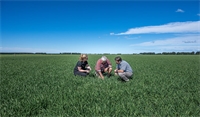Summer Agronomy Update 2024
Words by Bill Cabout, Ruralco’s Ashburton Store Manager
Spring once again has delivered a variety of weather conditions with mixed periods of cooler and then warmer weather. We have had regular rainfalls plus one big rainfall with reasonably good weather in between.
Climate Outlook for Next Few Months


Weather predictions for Canterbury for Nov 2024 to Jan 2025
Cereals
Cereal crops are looking very good currently with the potential to be a very good year for high yields. This yield potential depends on what happens over the next 8 weeks weather wise. We need good sunshine hours to help with the seed fill stage. Disease pressure is average so make sure you apply the relevant fungicides at the right stages to make sure that any late disease doesn’t affect your yields.
A new concept for NZ is growing a mixture of cultivars in one paddock. FAR is doing trials on this as well several growers trialling this as well. It is mainly being done with feed wheats as it could be a problem for milling with mills not being sure having a mixture of varieties is a good idea. The idea of this is that different cultivars have different reactions to the different diseases and by mixing them together the disease struggles to gain establishment and to spread through the crop, so overall disease is a lot less than in a single cultivar. Overseas results have shown there has been the potential of yield increases. The cultivars need to have similar maturity dates for this to work.
Pasture
Pasture growth in September was very slow with the cooler weather and several frosts. Once we moved into October and warmer temps appeared, pasture growth picked up. This continued into November. From the good growth we have seen in the last few weeks a lot of silage being made to help mop up any surpluses. Regular rainfall has helped, though most farmers are now irrigating to make sure the growth continues.
It takes 12 months to establish a new pasture and good management through this period will improve persistence, especially through the first summer. The most important grazing is the first one and should occur once plants cannot be pulled out of the ground, this helps tillering and growth and enables light to reach clover that can often establish slower in spring sown pasture. Always keep pastures relatively short (less than 3500kg/DM) which helps them tiller but try not to graze them too low reducing leaf and stem material affecting re-growth and plant reserves.
Competition
It is important to remember any sort of competition can affect the establishment of your crop or pasture. With the current good growing conditions, we are seeing rapid establishment of weeds in all types of crops and new pasture. Removing weeds at the earliest possible stage should give your crop every possible chance to achieve its best yield potential. Monitor crops and pastures closely for emerging weeds and disease. Work closely with the person monitoring your crops and ensure the resultant recommendations are completed as early as possible. It is also a good time of the year to tidy up fence lines, lane ways, and yard areas as problem weeds will start seeding through this period spreading viable seeds across pasture and cropping areas.
Fodder beet
Fodder Beet sowings this spring were delayed due to the cooler weather conditions in September. Plantings started in early October and continued throughout the month. This later planting has not affected the growth of the crop as the crop has had good establishment and if anything is catching up in growth stages on a normal season.
A good weed spray programme remains very important in getting the most out of your Fodder Beet crop. It is important not to wait too long for your next weed spray application as a delay of 2-3 days can make larger weeds harder to kill and while this puts extra pressure on contactors and spray trucks, look to book them a little bit earlier and work closely with your rep.
Kale
Kale sowings started in late October and will continue into mid-January. Over the last few years, we have seen an increase in the areas of Kale sown due to the ease of management through the growing season and at feeding time when compared to Fodder Beet. Even with the large range of sowing dates we are seeing similar yields come the winter and are even seeing good yields from dryland crops.
Maize
We have seen a slight increase in Maize seed sales this year. Maize establishment has been good this year with the crops growing well.
Related

The end of November, early December has finally brought some settled sunshine across the region, wit...
Read More

For the next 2 months we are looking at the final sprays for finishing off our cereal and grass seed...
Read More

Growing forage brassica crops for summer or winter feed take planning. Insect pests can limit brassi...
Read More

November’s Agrichemical Update focuses on getting the most from your spray programme. We cover cere...
Read More

November has kicked off in true Canterbury style with a dusting of Labour weekend snow. It’s been a...
Read More

Arable growers have launched a logo to champion NZ-grown grains in bread and cereals. With most supe...
Read More